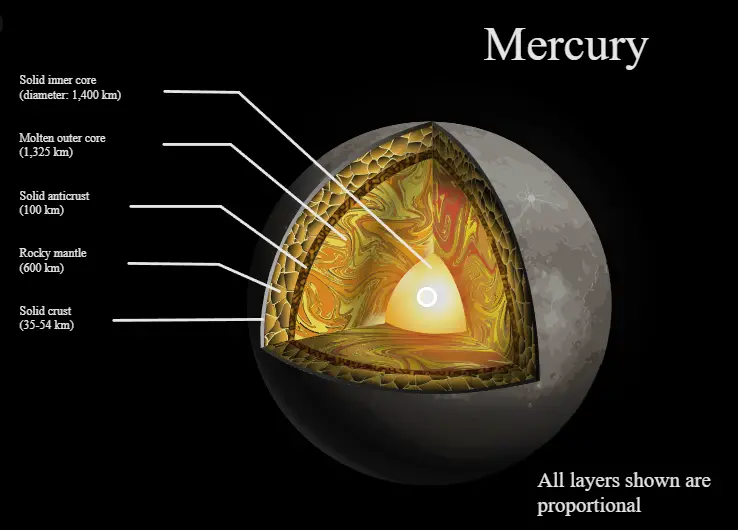Mercury is the smallest planet in our solar system that is closest to the sun. The Romans named it after their swift-footed messenger God as it is titled the fastest planet of all in space. This is because it is closest to the sun that makes its orbit smaller. Mercury is an intriguing planet with many interesting facts and figures that have surprised astronomers for quite a time. Even though mercury is closest to the sun, still it is not the hottest planet in the solar system, as this title is given to planet venus.
Mercury has been known to mankind since antiquity and was named after the Roman messenger god, Mercury. It’s the smallest planet in our solar system, and also the closest to the sun, orbiting at an average distance of 29 million miles away from it (compared to Earth’s 93 million miles). The surface temperature on Mercury can reach 800 degrees Fahrenheit, making it too hot to support life as we know it.
Density of Mercury
Mercury planet has a massive metallic core and is referred to as the second densest solar system planet. It is stated that the gigantic metallic core of this planet comprises around 75% of the planet’s diameter. Moreover, a substantial metallic core is combined with an abundance of volatile elements that makes this planet more intriguing.
Size of the Planet
Also known as the smallest planet in space, this planet is not much larger than the Earth’s moon. Moreover, the size of mercury has not remained constant in the past and nor does it stay the same now. This planet has always shrunk and has continued to do so till this time. This shrinking happens because mercury is made out of a single continental plate over a cooling iron core. Therefore, every time the body cools down, it solidifies, decreasing the planet’s volume.
Temperature of Mercury
As mentioned earlier, mercury is the closest planet to the sun, which has a high temperature and severe climate. Being so close to the sun, the temperature at mercury’s surface can rise to 840 degrees Fahrenheit, making it impossible for living beings to survive there. However, the temperature situation at mercury during the nighttime is the opposite. At night the temperature of mercury can drop down to approximately minus 275 degrees Fahrenheit. This is because the planet lacks any atmosphere that is responsible for trapping the heat. Such a massive temperature swing at this planet is the greatest one in the entire solar system.
Interesting Discoveries and Facts
Over time, many exciting discoveries have been made about this exciting planet. Some of the fascinating findings of this planet include;
- Moon of mercury
One of the fascinating facts about this planet is that it doesn’t have a moon of its own. This fact is also one of the primary reasons that no life can be sustained on this planet. Moreover, having no moon of its own is usually justified because this planet is too close to the sun, and the intense gravity makes it impossible to hold a moon.
- Mercuryquakes and Reshaping of the planet
It was discovered in 2007 that mercury has always experienced mercury quakes like the earthquakes responsible for its rumbling. Also, it is believed that the constant volcanic eruptions reshaped the mercury in the planet that stopped around 3.5 billion years ago.
- Mercury’s surface
Various discoveries over time have stated that the surface of mercury is divided into two groups. One of which comprises the old materials that have melted over time due to the high pressure, while the other one consists of the new materials that have developed on the surface of mercury.
- Days in Mercury’s year
Mercury’s year comprises 88 days.
![]()
